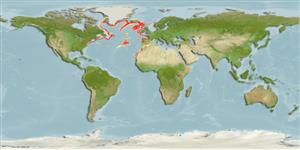Preferred temperature (Ref.
123201): 3.3 - 10.6, mean 5.8 °C (based on 143 cells).
Phylogenetic diversity index (Ref.
82804): PD
50 = 0.5039 [Uniqueness, from 0.5 = low to 2.0 = high].
Bayesian length-weight: a=0.00324 (0.00135 - 0.00777), b=3.15 (2.94 - 3.36), in cm total length, based on LWR estimates for this (Sub)family-body shape (Ref.
93245).
Niveau trophique (Ref.
69278): 3.0 ±0.0 se; based on diet studies.
Résilience (Ref.
120179): Milieu, temps minimum de doublement de population : 1,4 à 4,4 années (Assuming tmax>3; Fec=43).
Fishing Vulnerability (Ref.
59153): Low vulnerability (10 of 100).
Nutrients (Ref.
124155): Calcium = 59.6 [18.9, 140.1] mg/100g; Iron = 0.394 [0.163, 1.137] mg/100g; Protein = 17 [14, 19] %; Omega3 = 0.155 [0.053, 0.418] g/100g; Selenium = 15.5 [4.9, 43.6] μg/100g; VitaminA = 38 [4, 331] μg/100g; Zinc = 0.825 [0.441, 1.627] mg/100g (wet weight);
